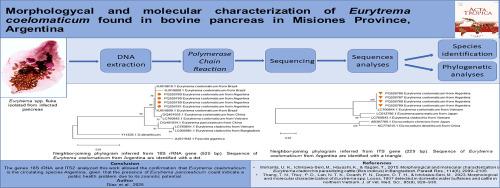阿根廷牛胰腺中发现的腔腹银耳的形态和分子特征。
IF 2.5
3区 医学
Q2 PARASITOLOGY
引用次数: 0
摘要
Eurytrema spp. flukes对反刍动物生产中的经济损失负责,导致胆管增生和肥大,管周纤维化和胰腺实质损失。这些吸虫会感染反刍动物、小型食肉动物,偶尔也会感染人类。本研究的目的是通过形态计量学和分子标记学对阿根廷吸虫进行精确鉴定,并阐明其系统发育关系。在阿根廷米西奥内斯省蒙特卡罗进行尸检时,从检查的品种牛的胰管中收集到Eurytrema吸虫。准确鉴定Eurytrema属的种类是很重要的,因为其中一些可以影响人类。据报道,在阿根廷、巴西和几个亚洲国家都发现了Eurytrema。本研究从蒙特卡罗采集了20只吸虫,通过形态特征鉴定为腔形吸虫(Eurytrema coelomaticum)。选取4个个体,针对18S rRNA和ITS2基因进行分子分析,由于Eurytrema种间形态分类不一致,进行序列分析确认鉴定。对于这两个基因,我们进行了与参考序列的多次比对,构建了系统发育树,并在两两比较的基础上实现了遗传分化分析。基于18S rRNA序列的系统发育分析表明,阿根廷的体腔绦虫与巴西的体腔绦虫序列高度相似,18S rRNA基因差异率低,与中国和越南的体腔绦虫形成了一个单独的类群,在亚洲体腔绦虫分离株中没有发现序列差异。这表明来自南美洲和亚洲的鞘翅蝽在进化上存在分歧。本研究首次获得了南美coelomatium的ITS2基因序列,该序列与越南coelomatium的ITS2基因序列具有100%的相似性。调查结果证实,体腔肠杆菌正在阿根廷流行,因为胰腺肠杆菌的存在由于其人畜共患的可能性而构成潜在的公共卫生风险。必须通过流行病学和分子监测继续监测该国的Eurytrema物种。本文章由计算机程序翻译,如有差异,请以英文原文为准。

Morphological and molecular characterization of Eurytrema coelomaticum found in bovine pancreas in Argentina
Eurytrema spp. flukes are responsible for economic losses in ruminant production, leading to hyperplasia and hypertrophy of the bile ducts, periductal fibrosis and loss of pancreatic parenchyma. These flukes affect ruminants, small carnivores and occasionally humans. The aim of this study was to perform a precise identification by morphometry and molecular markers in Eurytrema flukes from Argentina, also clarify their phylogenetic relationships. Eurytrema flukes were collected from the pancreatic ducts of breed cattle examined during necropsies in Montecarlo, Misiones province, Argentina. Precise identification of species of the genus Eurytrema is important because some of them can affect humans. Reports of Eurytrema species have in Argentina, Brazil and several Asian countries. In this study, we identified 20 Eurytrema flukes as Eurytrema coelomaticum by morphological characters, collected from Montecarlo. Four individuals were selected for molecular analyses targeted to 18S rRNA and ITS2 genes, with sequence analyses conducted to confirm identification due to the conflicting morphological classification among Eurytrema species. For both genes, we performed multiple alignments with reference sequences, constructed phylogenetic trees and realized an analysis of genetic divergence, based on a pairwise comparison. Phylogenetic analyses based on 18S rRNA sequences revealed that E. coelomaticum from Argentina shows high similarity with sequences from Brazil with low percent of 18S rRNA gene divergence, forming a separate group from E. coelomaticum found in China and Vietnam, no sequence variation was observed among this Asian E. coelomaticum isolates. This indicates there is evolutionary divergence between E. coelomaticum from South America and Asia. This study presents, for the first time, the sequence of the ITS2 gene for E. coelomaticum from South America, which showed 100% similarity with E. coelomaticum isolated from Vietnam. Findings confirmed that E. coelomaticum is circulating in Argentina, as the presence of E. pancreaticum poses a potential public health risk due to its zoonotic potential. Continued monitoring of Eurytrema species in the country is essential through epidemiological and molecular surveillance.
求助全文
通过发布文献求助,成功后即可免费获取论文全文。
去求助
来源期刊

Acta tropica
医学-寄生虫学
CiteScore
5.40
自引率
11.10%
发文量
383
审稿时长
37 days
期刊介绍:
Acta Tropica, is an international journal on infectious diseases that covers public health sciences and biomedical research with particular emphasis on topics relevant to human and animal health in the tropics and the subtropics.
 求助内容:
求助内容: 应助结果提醒方式:
应助结果提醒方式:


